© 2025 - All Rights Reserved
These are the 2024 bird news weekly update photo breaks. Often filling in blanks of species we had not posted yet. Sometimes documenting something seen. Occasional reruns used to show something being seen or just seen recently. They are point-and-shoot study material or documentation grab-shots from the hip. Generally overly tight crops to reduce file sizes, and merely for illustration. They are in reverse chronological order as used in bird news weekly photo break. Most recently used in late Dec., at top; first in Jan. at bottom-end. They were mostly taken with a Canon Powershot SX40, some may have been chisled onto a floppy disk with a Sony Mavica.
~ ~ ~ ~ ~
The 2025 pix
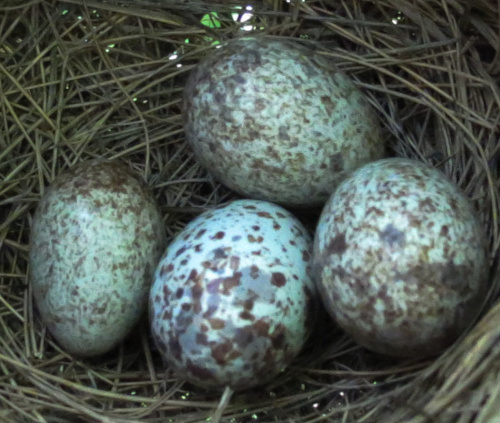
This is the Cardinal nest that was right out kitchen window. There are three Cardinal eggs and one obviously smaller egg, which is from a Brown-headed Cowbird egg (left). The nest was parasitized. Worry not, then the whole nest was predated and all eggs were eaten. So first it was parasitized, then predated. Either a Fox Squirrel or the Ringtail. It happened in the morning. Someone asked me what to do if they found a Cowbird egg in a nest. They said the internet says to leave it, and let nature take its course, it is natural. The act is natural. The Cowbird population is not. Man made cowbirds a hundred times more common than they would be had we not cleared all the land. The rate of nests being parasitized is factors higher than what is natuiral. It would be illegal for me to say to toss the egg, so I won't. But it would not break my heart to find out something predated the parasites egg. Man should take responsibility for making the cowbird abundant where it was not.
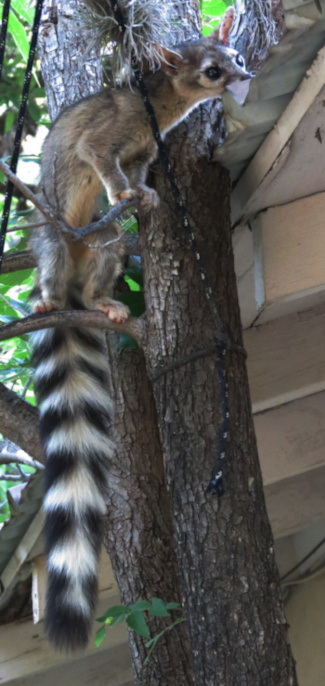
Here is a pic Kathy got of the Ringtail as it ran up tree next to house. We heard from a neighbor it was found dead, probably mauled by dogs in yard. So it is no more.
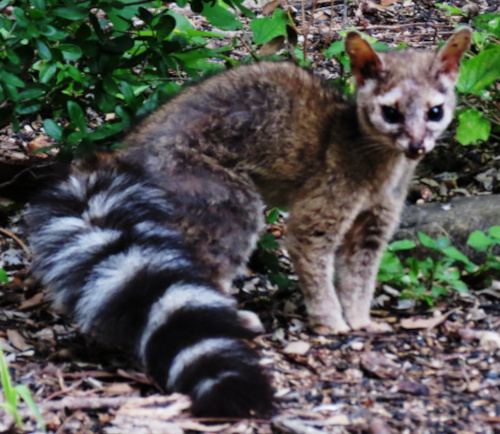
This is the Ringtail we have been seeing around our place the last week or so. And likely what predated the Cardinal nest. Often called Ringtailed Cat, however it is not a feline, so a very poor name. Cacomistle used to be a commonly used name for them. I watched one grab a bat out of the air from the lip of the Concan bat cave as they departed. They can jump 12 feet from a standing start. Some furriers take them for their pelts.
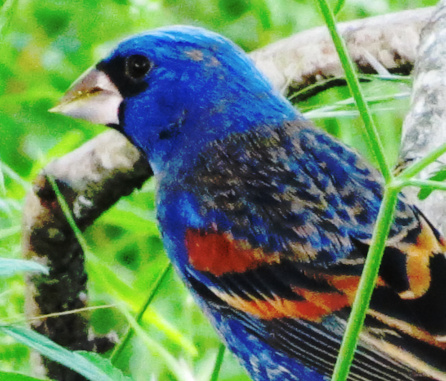
Blue Grosbeak, male. Unfortunately it was under overcast skies so the blue is not lit up. In the sun, they can knock your blue receptors out. Nests along watercourses in riparian habitats, like the river habitat corridor, and even in canyons such as along the streams at Lost Maples. The color of the wingbars can be called rufous, cinnamon, chestnut, or bay, all correctly. Female is brown with big buffy wingbars.
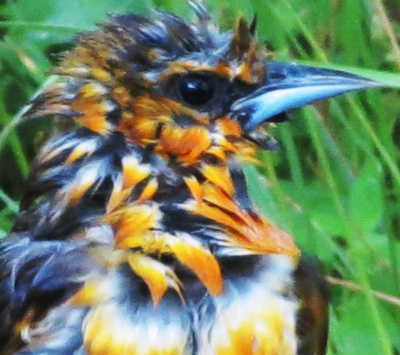
This is a rather messy first spring male Bullock's Oriole. It is very wet. The dark areas in the orange plumage are the bases of theorange feathers, not usually visible, but splayed apart to get lots of water everywhere. They are not an external plumage character. Key are the orange eyeline and it did have a nice hourglass bib on throat. It could be an intergrade with a Baltimore, but I think is OK for Bullock's.
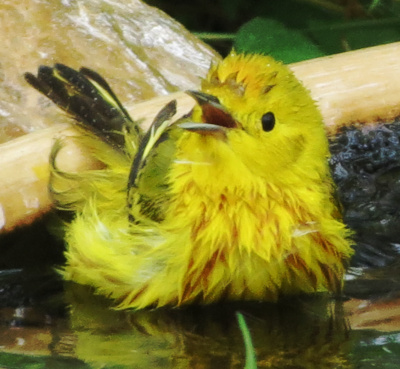
Well it is spring, so there will be Yellow Warbler at the bath. The red streaks on underparts will double or more in brightness and boldness over the next few weeks on its way to its breeding grounds.
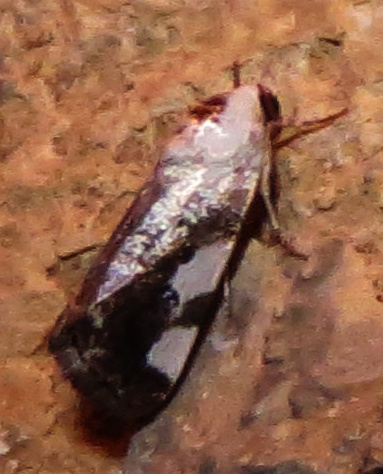
Another exciting moth.
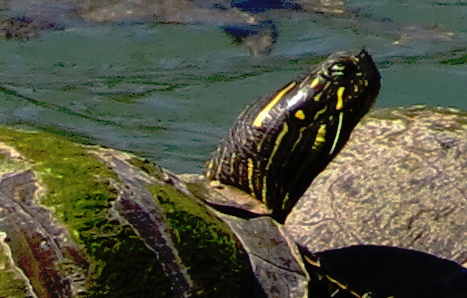
This is a Texas River Cooter. They are overall more blackish green than the olive of a Red-eared Slider. The green on this ones back is algae growth. They lack the red ear patch of course as well. They are common in the river here.
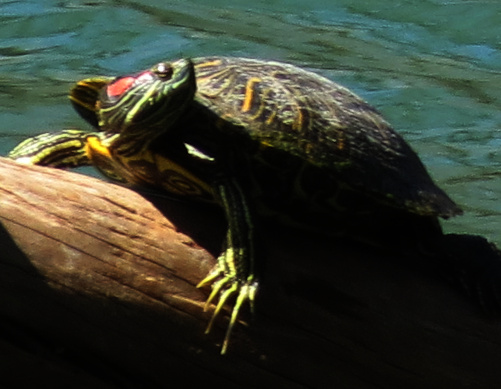
This is a Red-eared (aka Pond) Slider. Our most common Turtle. There is a log in the pond at the park we counted 29 turtles on, plus 10 in the water vying for a space. Most were Red-ears, but some Texas River Cooter there too.

Well it is spring after all, so here ya go. This male Golden-cheeked Warbler sang around the yard and visited the birdbath on April 3.. Whaddabird!

Another exciting moth to ponder. This one could pass for one of the bird dropping moths, of which there are countless variations.

Another exciting brown moth to ponder. This one is what is called mottled. How could you see that on tree bark?

The latest thrilling installment of exciting brown moths. This one is fairly pale and has some spots that sorta look like eyes.

This is a closeup of one of the Pllyphemus moths at the store last August. Anntennae like this are well-named as feathered. It is the males that have the big oversized ones, to detect females.

Hope you did not miss moths too much. This is an Accrea moth. Their caterpillars are also wooly bear real fuzzy types. Pretty yellow body on them when visible. Often called Saltmarsh moth, but which seems a misnomer here.

I tried to get a pic of the Red-winged Blackbird flock coming in to eat white millet. But they flushed. I liked it anyway. Actually it is harder to get an image like this with a camera than it would be to paint it - LOL.

Since they are so awesome, here is another brown moth. If you ever gave them a good hard look, the variation alone would blow your mind. Endless patterns and variations on how to camoflage oneself. We do not get to see the ones that did not work out. These are the successful examples.

After all that beauty last week, this should calm you down. A nice brown moth. Of course I have no idea what type. Moths are to browns what plants are to greens.

This is the Golden-winged Warbler that was at our birdbath last April 30. My favorite bird of the year last year. Despite the Crow being rarer here, it wasn't all that to look at.

This is the same female Anna's Hummingbird as two weeks ago. Only have poor pics of the imm. male, none of the ad. male so far. The bright area at tip of the bill is its tongue sticking out. The bill ends where it goes all dark black. All left of that is tongue.

I think this is a moth, an odd one at that. It was near a couple inches long. Oct. 4, 2024

This is one of the Anna's Hummingbird here now. An imm. or female, e.g., a non-adult male. Photo taken Jan. 7, 2025. This is bird No. 2. Have pics of the all black tail growing in on the imm. male bird No. 1.
~ ~

Just to give an idea, here is a pic showing part of the yard, house and cottage, so you can get an idea of where much of the stuff being written about is being seen. This pic was May 2013, barely two months after we moved into this place. Now there are butterfly flowers around the porch and in flower beds. The yard lists are: 45 species of odes (dragons-damsels), 99 sps. of butterflies, 7 sps. of frogs & toads, 7 sps. of native lizards, 9 sps. of native snakes (two more out on the road), 20 sps. of native mammals, about 100 sps. of plants (mostly native wildflowers), and now at the 12 year point, about 235 native species of birds.
Quick links to the last few years ...
2023 pix
2022 pix
2021 pix
2020 pix
2019 pix
2018 pix
2017 pix
2016 pix
2015 pix
If you have arrived here from our Bird Photos page, you may close your browser to return to the Bird Photos index.
Other visitors may click your "Back" button on your browser or select a link to keep visiting!

To Bird Photo Main Menu

To Butterfly Pics

To Dragonfly & Damselfly Pics

To Current Bird News
Birds
Utopia Birds
Birding Sites
Bird List
Bird Guide
Reports from Lost Maples
Winter Bird Count
Butterflies
Butterfly News
Butterfly List
Butterfly Photos
Rare Butterflies
Dragonflies
Critters, Bugs, & Stuff
Lost Maples
Garner State Park
Local Site Guide
Home

Our E-mail
mitch @ utopianature.com
 All photographs within this site are copyrighted
All photographs within this site are copyrighted